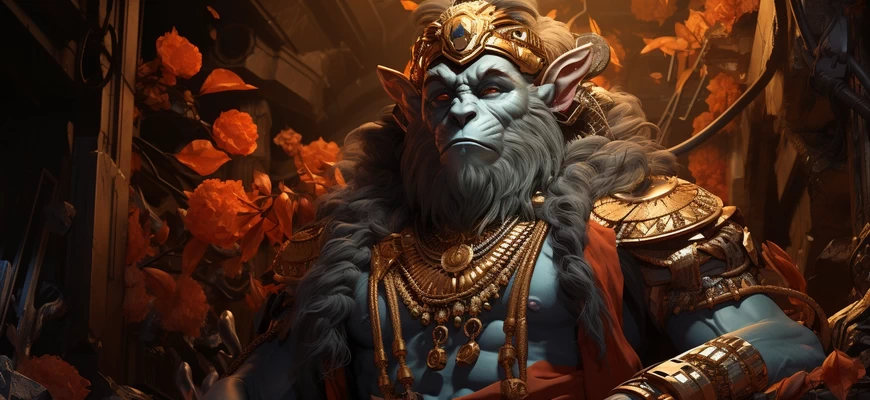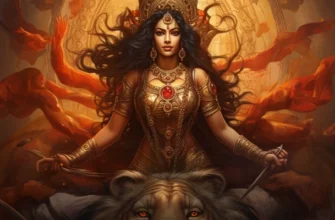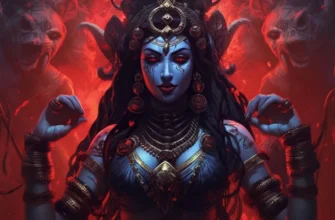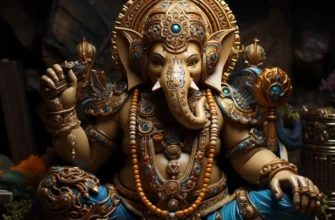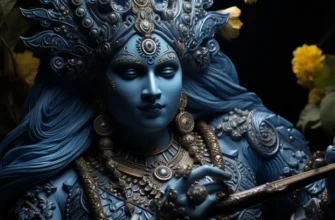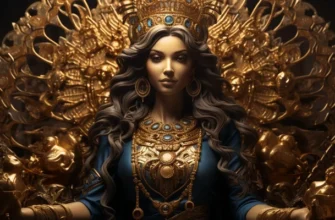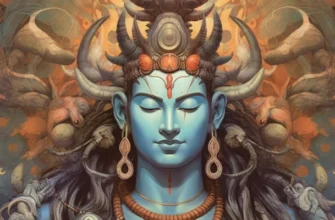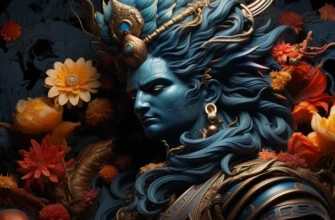Hanuman, the monkey god in Indian mythology, is known for his devotion to Rama and incredible strength. He is an important symbol of faith and courage in the Indian cultural context. He is often revered for his devotion and unselfishness. Hanuman is often honored in temples and during religious festivals.
- Origin and history
- Legends from ancient writings
- Hanuman’s characteristics and distinguishing features
- Physical description and symbolism
- As for the symbolism:
- Spiritual and mythological attributes
- Hanuman’s role in the Ramayana epic
- Interaction with other characters
- Key moments and actions
- The cult of Hanuman in Indian society
- Modern perception and importance for the present
- Influence on contemporary Indian culture and society
- Meaning and interpretation in the modern world
- Conclusion
Origin and history
The origin and history of the Indian god Hanuman are reflected in Indian epics and mythology. He was born in the mythological world of India and has numerous legends related to his origin. However, one of the most famous versions of his origin concerns the divine union of the wind god Vayu and the underground goddess Anjana. The windmill, which breathes life into all creatures, gave up its energy, and Anjana gave birth to Hanuman, who also received blessings from various gods, giving him extraordinary abilities such as extraordinary strength and invulnerability.
Hanuman’s story is further revealed in the Ramayana epic, where he plays a key role. He became a loyal follower and servant of the god Rama, helping him in many adventures and battles. Hanuman is also known for his devotion to Rama and his wife Sita.
Hanuman is a symbol of loyalty, devotion, courage and boundless love for God Rama. He is an object of worship and honor in Indian society and is one of the most revered gods in Hinduism.
Legends from ancient writings
There are numerous legends about Hanuman that can be found in ancient Indian writings. Some of them include stories of his deeds and exploits, such as his transformation of great size to cross the ocean in search of Sita, or his bravery in fighting demons threatening the world. The legends also tell of his extraordinary strength and abilities that helped him fulfill his divine duties and protect his worshippers. These legends are meant to set forth the meaning and symbolism associated with Hanuman’s image, as well as add to his divine status in Hinduism.
Of course, here are some of the legends associated with Hanuman:
The legend of crossing the ocean to find the City.
The legend of crossing the ocean is related to Hanuman’s mission to find Sita, the wife of the god Rama, who was kidnapped by the demon Ravana. According to this legend, Hanuman crossed a wide ocean, showing incredible abilities, to reach the island of Lanka, where Sita was being held. He overcame numerous obstacles, encountering sea monsters and demons, but through his courage and loyalty he found Sita, giving her the summons from Rama and proving his loyalty to his master. This legend emphasizes Hanuman’s boundless devotion and extraordinary courage in fulfilling his mission.
The legend of fighting demons and criminals to protect the world.
The legend of Hanuman fighting demons and criminals reflects his incredible strength and fearlessness in protecting the world from evil. According to this legend, Hanuman engaged in implacable battles with numerous demonic forces that threatened the peaceful world. His extraordinary abilities helped him defeat his enemies, and his courage and loyalty helped to save the world from the dark forces. This legend emphasizes Hanuman’s role as a defender of good and a symbol of the fight against crime and antiquity.
The legend of his ability to change his size to achieve impossible tasks.
The legend of Hanuman’s ability to change his size reflects his extraordinary capacity and ability to achieve impossible tasks. According to this legend, Hanuman could change his size from the smallest to the largest size, which allowed him to overcome even the most difficult obstacles and achieve the unattainable. This extraordinary ability underscores his divinity and reflects his role in accomplishing missions that seemed impossible to many.
The legend of his courage and loyalty in the service of the god Rama and Sita.
The legend of Hanuman’s courage and loyalty in the service of God Rama and Sita demonstrates his unquestioning devotion and boundless love for his divine masters. According to this legend, Hanuman served Rama and his wife Sita unconditionally, fulfilling all their wishes and missions with great devotion and enthusiasm. His loyalty and devotion were unwavering even in the most difficult situations, as reflected in the numerous stories of his service and selflessness. This legend emphasizes the importance of loyalty and dedication in fulfilling one’s duties, regardless of the circumstances.
The legend of his extraordinary strength and abilities that made him invincible in battles with the forces of evil.
The legend of Hanuman’s extraordinary strength and powers reflects his divine qualities that made him invincible in battles against the forces of evil. According to this legend, Hanuman had incredible physical strength that allowed him to easily defeat enemies and demons. His extraordinary abilities also included speed, martial arts skills, and invulnerability to many types of attacks. These attributes helped him to protect the world from the forces of evil and to fulfill various divine tasks with unwavering confidence and self-assurance.
Hanuman’s characteristics and distinguishing features
Hanuman is known for his devotion, immortal loyalty to the god Rama, extraordinary physical strength, and ability to change his size. He is also known for his courage, wisdom, and dedication to serving Rama and his wife Sita. His symbolism includes the hammer he used in battles and the mountain herbs that granted him immortality. In Hinduism, he is revered as a symbol of loyalty, devotion, courage, and boundless love.
Physical description and symbolism
The physical description of Hanuman often includes the following features:
Monkey form: He is usually depicted as an anthropomorphized monkey with a long tail and ears.
Golden Eyes: In many depictions, he has golden or light eyes, symbolizing his divine nature.
Great physical strength: Hanuman is often depicted as a muscular and strong figure, reflecting his extreme strength.
As for the symbolism:
Hammer: The hammer in Hanuman’s hands symbolizes his strength and determination in overcoming obstacles and enemies.
Mountain herbs: He often holds mountain herbs in his hands, which have medicinal properties. This symbolizes his ability to solve problems and cure hardships.
Open chest: Hanuman can be depicted with his chest open, which expresses his openness and loyalty.
This symbolism indicates the key traits and characteristics of Hanuman in Hinduism.
Spiritual and mythological attributes
Hanuman’s spiritual and mythological attributes include:
Loyalty: He symbolizes loyalty in the service of the god Rama and devotion to his ideals, making him an example of deep religious faith.
Devotion: Hanuman is famous for his boundless devotion and dedication to Rama, setting an example of self-sacrifice and dedication in the name of a higher ideal.
Wisdom: He is considered to be a symbol of wisdom, which is manifested in his strategic actions and ability to find solutions even in the most difficult situations.
Strength: Hanuman is known for his incredible physical strength, which symbolizes his ability to overcome any obstacles and protect against evil.
These spiritual and mythological attributes deeply embody Hanuman’s spiritual essence and significance in the Hindu tradition.
Hanuman’s role in the Ramayana epic
In the Ramayana epic, Hanuman plays a number of important roles:
Searching for Sita: He plays a crucial role in the search for the wife of the god Rama, Sita, who was kidnapped by the demon Ravana. His fearlessness and courage help him overcome numerous obstacles and find Sita.
Rama’s messenger: Hanuman acts as Rama’s messenger to Sita, helping to establish contact between them during her detention on the island of Lanka.
Military advisor: He provides Rama with strategic advice and assists in forming alliances with other apes to fight against Ravana and his demonic army.
Demon fighter: Hanuman is involved in numerous battles with demons and other evil forces, protecting Rama and his followers from danger.
Hanuman’s role in the Ramayana emphasizes his importance in the triumph of good over evil and his dedication to serving Rama and defending righteousness.
Interaction with other characters
In the Ramayana, Hanuman interacts with other characters including:
Rama: Hanuman shows deep devotion and serves Rama as his loyal follower and close collaborator.
Sita: He acts as Rama’s messenger to Sita, whose liberation becomes one of his main goals.
Lakshman: Hanuman partners with Lakshmana, Rama’s brother, in many important missions and battles, supporting him in his efforts.
Ravana: Hanuman clashes with Ravana, Rama’s demonic enemy, in many of the epic battles that are central to the Ramayana story.
These interactions emphasize Hanuman’s importance in the Ramayana story and his role in helping Rama and his allies fight the forces of evil.
Key moments and actions
In the Ramayana, Hanuman’s key moments and deeds include:
Crossing the Ocean: His incredible bravery and loyalty were shown in crossing the wide ocean to find Sita and free her from Ravana’s captivity.
Meeting with Sita: He meets Sita on the island of Lanka, expressing his devotion to Rama and sending her his message.
The kidnapping of Lakshmana: Hanuman assists in the rescue of Lakshmana, who has been kidnapped by Ravana, and shows his courage in fighting the demonic forces.
The battle with Ravana: He takes part in the decisive battle with Ravana, showing his incredible strength and dedication in the fight for the victory of good over evil.
These key moments and actions of Hanuman add tension and drama to the story of the Ramayana and emphasize his prominent role in the epic story.
The cult of Hanuman in Indian society
The cult of Hanuman in Indian society manifests itself in many ways:
Temples and shrines: There are numerous temples dedicated to Hanuman throughout India where devotees gather for prayers and worship.
Religious rites: His name is frequently used in religious rites, prayers, and celebrations, indicating the importance of his cult in the Hindu tradition.
Festivals: There are special festivals dedicated to Hanuman, during which his devotees organize religious rites, prayers and ceremonies in honor of the god.
Legends and folk tales: The legends of Hanuman have been passed down through generations in the form of folk tales and stories, adding to his cultural significance.
The cult of Hanuman is deeply rooted in Indian religious and cultural heritage, which is indicative of his important place in the hearts of Indians.
Modern perception and importance for the present
In today’s world, the cult of Hanuman remains an important aspect of Indian culture and religious perception. It continues to be a symbol of loyalty, devotion, and courage, inspiring believers to embody these qualities in their lives.
In the modern world, the cult of Hanuman also helps to preserve and revive the traditions and values of Indian culture. He serves as an example of willpower and steadfastness in the fight against evil and darkness, which can inspire hope and set a course for modern believers.
The modern perception of Hanuman is also marked by his veneration as a symbol of inner strength and spiritual development, which can inspire people to strive for self-compassion and self-development. His cult continues to be an important source of inner strength and peace in the modern world, where people seek spiritual fulfillment and harmony.
Influence on contemporary Indian culture and society
Hanuman has a significant influence in contemporary Indian culture and society that manifests itself in many ways:
Religious influence: His cult remains an important aspect of the Indian religious experience, influencing religious practice, rituals, and celebrations.
Cultural influence: Hanuman’s legends and stories continue to influence Indian culture, art, literature, and folk traditions, enriching the country’s cultural landscape.
Social impact: His symbolism of loyalty, devotion, and strength inspires society to strive for moral strength and inner development.
Political influence: Hanuman also has an impact on political discourse in India, where his image is used as a symbol of strength, courage, and national unity.
This influence of Hanuman in contemporary Indian culture and society underscores his importance in shaping values, ideals, and identity in modern India.
Meaning and interpretation in the modern world
In today’s world, Hanuman is interpreted as a symbol of inner strength, courage, and loyalty that can inspire people to face life’s challenges and overcome difficulties. Its meanings include:
A symbol of inner strength: The Hanuman serves as an example of how inner strength and will can help overcome even the greatest obstacles and achieve a goal.
Devotion and loyalty: His loyalty and unquestioning devotion to Rama and Sita are interpreted as important qualities that can inspire people to be faithful to their goals and ideals.
Interaction with evil: Hanuman is also interpreted as a symbol of the fight against evil and darkness, which helps people maintain moral strength and uphold righteousness.
A symbol of spiritual development: His image can also be interpreted as a symbol of spiritual development and self-knowledge, which encourages people to seek inner harmony and peace.
These interpretations of Hanuman in the modern world reflect his significance as a symbol of inner strength and spiritual development, which can inspire people to achieve inner harmony and strong character.
Conclusion
Hanuman, the Indian god, plays a key role in Hindu mythology and culture. His loyalty, courage, inner strength, and extraordinary abilities make him an integral part of the Indian spiritual tradition. Through the legends of his exploits in the fight against evil and his faithful service to the god Rama, he serves as an example of devotion and courage for believers. His significance in today’s world emphasizes the importance of inner strength and moral fortitude, which can inspire people to overcome difficulties and achieve inner peace. Hanuman is integrated into society as a symbol of spiritual development and inner self-improvement, which helps people to preserve their values and ideals in the modern world.
